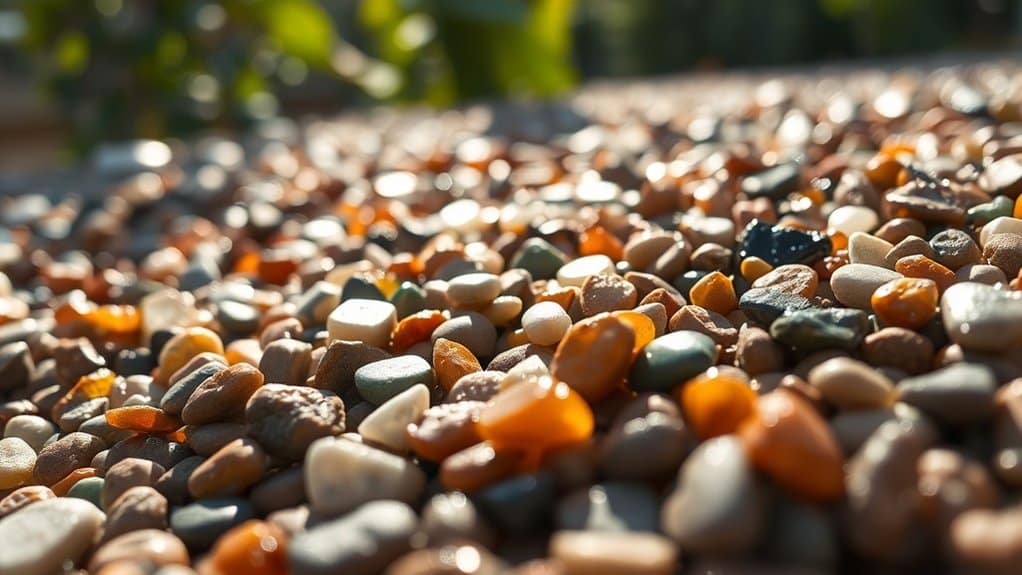Sealants are crucial for maintaining resin-bound gravel surfaces. They enhance durability, deter weed growth, and improve safety by reducing loose stones. Additionally, sealants shield against environmental factors, improve permeability for effective water drainage, and can extend your surface’s lifespan to 15–30 years with proper upkeep. Regular inspections and reapplication every 5–8 years help keep your surfaces looking fresh. It’s also important to understand the application process and how to select the right sealant for optimal results.
Key Takeaways
- Sealants enhance the durability of resin-bound gravel, preventing stones from shifting and ensuring a stable surface.
- They improve safety by reducing loose stones, making outdoor areas safer for children and pets.
- Sealants help block weed growth, which can significantly cut down on maintenance for gravel surfaces.
- Applying sealants boosts resistance to UV rays and moisture, safeguarding the resin from environmental wear and tear.
- Regular resealing every 5 to 8 years helps maintain the appearance and extends the lifespan of your gravel surfaces.
Purpose and Benefits of Sealants in Resin-Bound Gravel
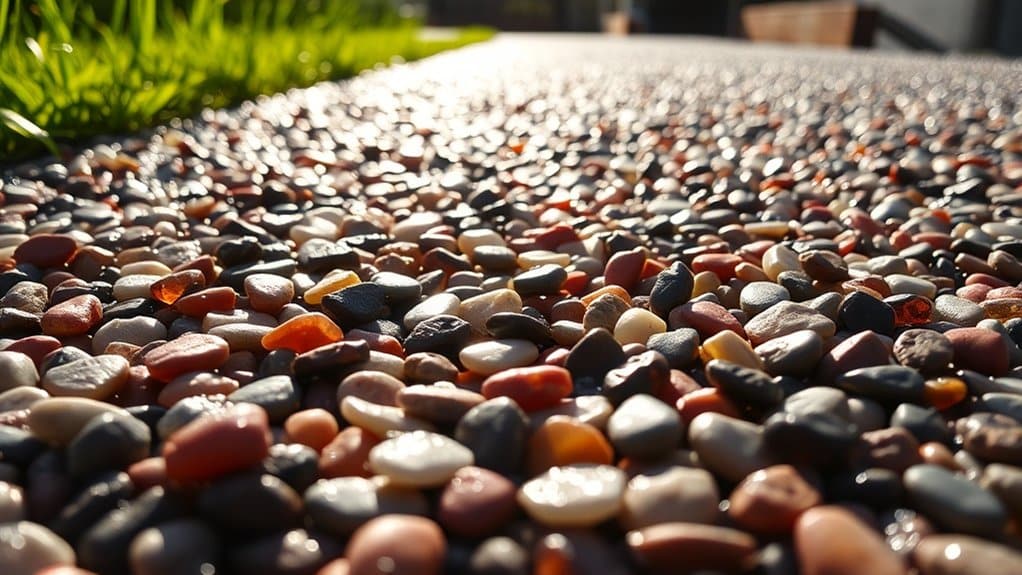
You mightn’t think about using sealants for resin-bound gravel, but they play a vital role in maintaining the surface’s durability and stability.
Different types of sealants are available, but their main job is to keep the aggregate securely in place, which helps prevent stone migration and surface instability. Regularly checking the drainage condition ensures that any issues that could undermine the integrity of the sealant are promptly addressed.
When applied correctly, sealants create a strong, seamless surface that resists shifting, potholes, and uneven wear. This not only enhances safety by removing loose stones but also makes the area safer for children and pets. Additionally, sealants help block weeds from growing, which reduces maintenance efforts. With a stable surface, accessibility improves for walkers and mobility aids, ensuring your resin-bound gravel remains functional and visually pleasing for years to come. Furthermore, the use of sealants is essential for maintaining the durability in Saudi Arabia’s climate, as they enhance the longevity of the surface against harsh weather conditions.
Impact of Sealants on Resin-Bound Gravel Durability
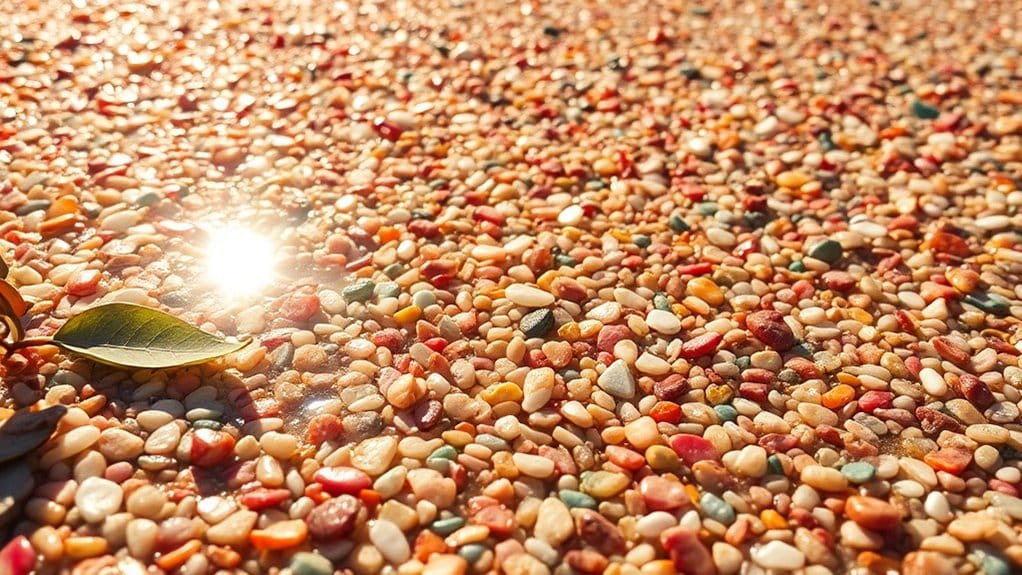
Applying sealants to resin-bound gravel significantly boosts its durability and performance. Sealant types, such as UV-resistant or moisture-repellent options, protect against environmental factors like temperature changes and freeze-thaw cycles. Proper application ensures even coverage, reducing the likelihood of cracks and moisture ingress. These sealants create a barrier against damaging substances, including oils and cleaning products, safeguarding the resin. In addition, applying a suitable UV-resistant sealant contributes to enhanced protection against fading and degradation from sun exposure. By preserving the gravel surface, you enhance its appearance and prolong its lifespan. Sealed surfaces are better equipped to handle heavy rainfall and debris, minimising erosion and wear, which is crucial for maintaining durability and longevity in various weather conditions.
Maintenance and Longevity Advantages of Sealants
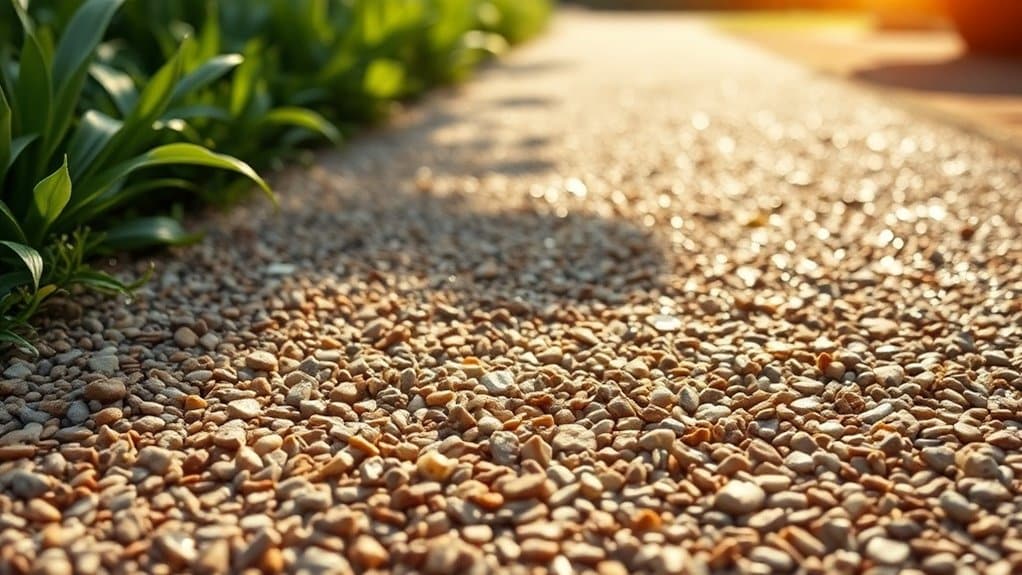
Applying sealants to resin-bound gravel enhances its appearance and simplifies maintenance, ensuring durability and structural integrity. UV-stable sealants prevent colour fading, keeping surfaces vibrant. Resealing every 5–8 years reduces dirt build-up and the need for extensive cleaning, making sealed surfaces easier to maintain. Additionally, regular maintenance practices, such as gentle washing, further contribute to the longevity of the surface. Regularly scheduled check-ups with qualified installers not only help address potential issues early but also ensure that your sealant and surface are in optimal condition. Spills and stains are less likely to penetrate deeply, and sealants also help curb the growth of moss and weeds. This proactive maintenance approach can extend the lifespan of your surface to 15–30 years, delaying costly replacements and repairs. Ultimately, using sealants leads to significant cost savings through lower maintenance and reduced labour over time.
Effects of Sealants on Environmental and Functional Properties
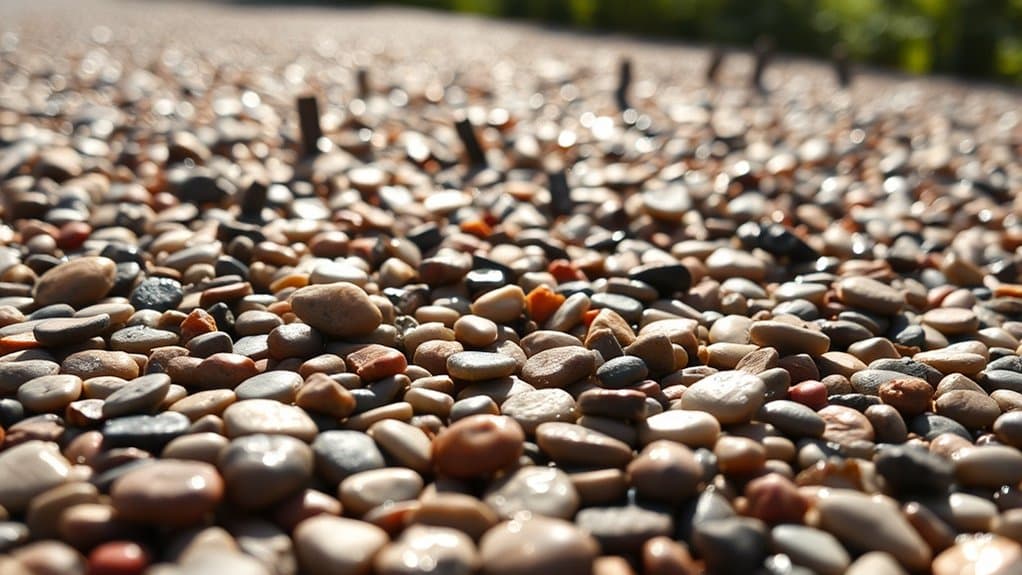
Sealants significantly improve the environmental and functional properties of resin-bound gravel, ensuring efficient performance and sustainability.
Different types of sealants enhance permeability, allowing for effective water management, which reduces surface runoff and the risk of flooding. They help meet the requirements of Sustainable Urban Drainage Systems (SUDS) by facilitating natural drainage and replenishing groundwater.
Moreover, sealants block pollutants from entering local water bodies, filtering contaminants during rainwater infiltration. The environmentally friendly materials used in these sealants help lower carbon footprints and promote sustainability.
Sealant Application Process and Considerations
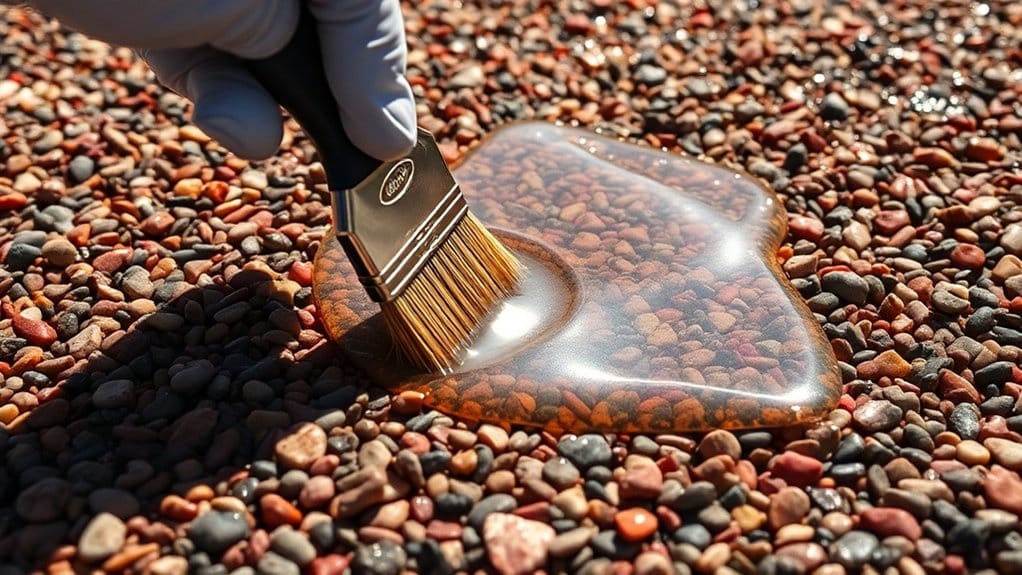
For the best results in applying sealant, preparation and attention to detail are crucial.
Begin by masking edges to prevent resin from spilling onto adjacent surfaces. Ensure the base is clean, stable, and dry, and avoid applying during wet weather.
When mixing, adhere to the manufacturer’s recommended resin-to-aggregate ratios and use a forced action mixer for even consistency.
Apply sealant in manageable sections with trowels or spreaders, aiming for a thickness of 15-20 mm. Use tamping techniques to remove air voids.
Keep ambient temperatures between 10°C and 30°C for optimal curing.
Finally, inspect the surface for uniformity and protect it from moisture during the curing period, which lasts between 24 to 72 hours, to guarantee durability and adhesion.
Common Challenges and Limitations With Sealants
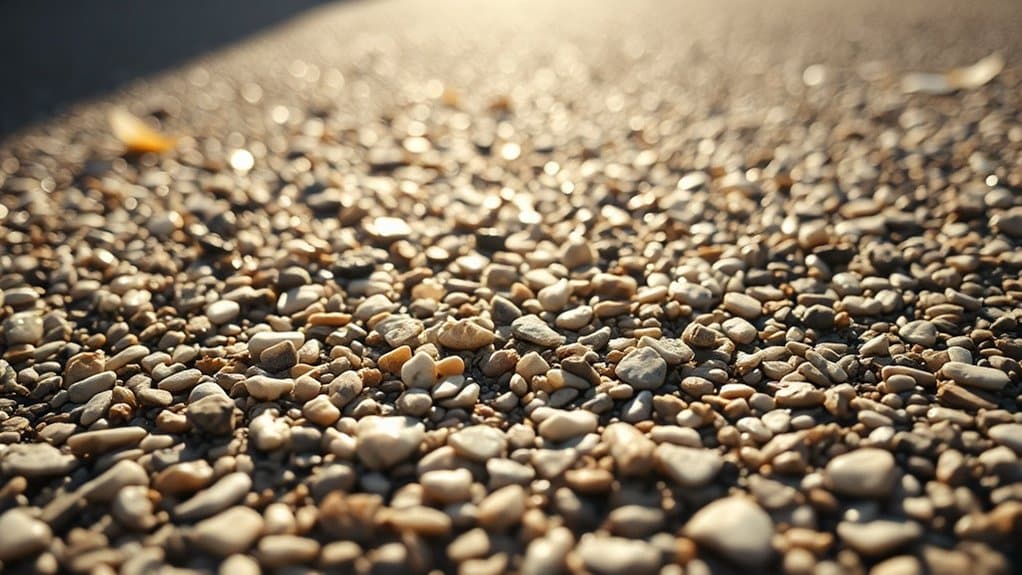
When applying sealants to resin-bound gravel, using too much can cause problems like surface peeling or uneven curing, which can undermine the overall integrity.
It’s also important to consider the environmental impact of certain sealant chemicals, as they can harm local ecosystems and water quality. Being aware of these challenges is crucial for achieving a long-lasting and sustainable surface.
Potential Over-Application Issues
Applying sealants can improve the durability and appearance of resin-bound gravel, but over-application can lead to several issues that compromise the surface.
When too much sealant is used, it can become tacky, attracting dirt and diminishing the overall look. This can also cause uneven curing, resulting in blotchy patches and reduced grip, especially in wet conditions.
Moreover, excessive sealant can weaken the bond between the resin and the aggregate, leading to cracks or delamination. Longer drying times can expose the surface to potential damage, while thick layers may become brittle, leading to expensive repairs.
Environmental Impact Concerns
Sealants can improve the performance of resin-bound gravel, but they come with significant environmental concerns. Many sealants contain epoxy or polyurethane-based resins that emit volatile organic compounds (VOCs), which can degrade air quality during application.
Furthermore, chemical additives can pose ecological risks if they enter waterways, potentially harming aquatic life and soil organisms.
Sealants can also diminish the natural permeability of gravel, leading to increased flood risk and erosion. As they break down, they may contribute to microplastic pollution.
Frequent reapplication of these sealants adds to resource consumption and raises sustainability questions.
The Importance of Regular Sealant Reapplication
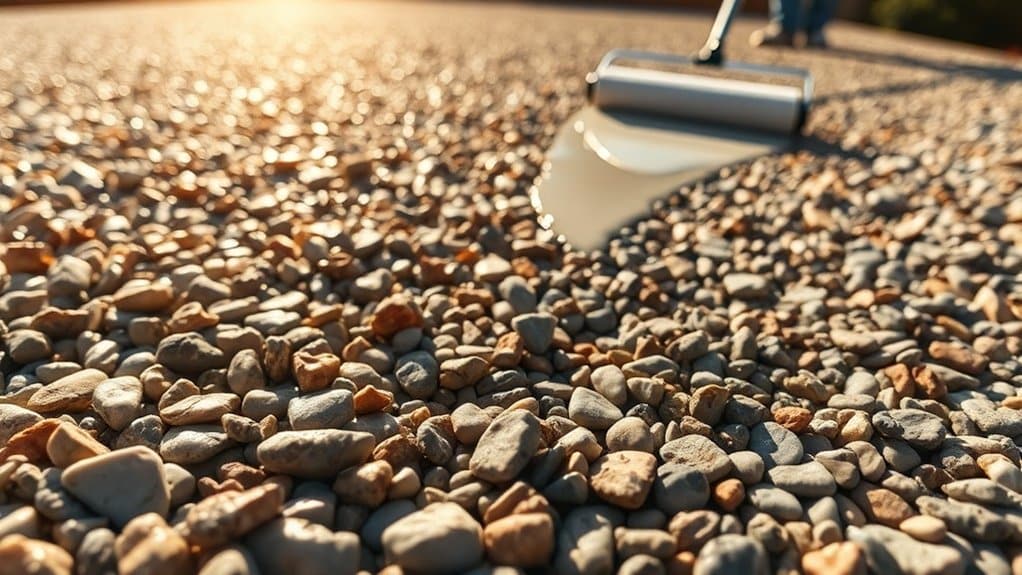
Regularly reapplying sealant is crucial for prolonging the life of your resin-bound gravel surface.
It shields the surface from environmental damage and ensures proper drainage by maintaining permeability.
Keeping up with this routine not only boosts the durability of your installation but also enhances its effectiveness.
For instance, a well-sealed surface can better withstand the UK’s wet weather, preventing issues like puddles or erosion.
Extended Surface Lifespan
To ensure your resin-bound gravel surface lasts, it’s important to reapply sealant regularly. Generally, you should reseal every 3 to 5 years, depending on the manufacturer’s recommendations and local weather conditions.
Opt for UV-resistant sealants for areas exposed to sunlight to prevent colour fading and UV damage. Proper application is crucial; make sure to thoroughly clean the surface before sealing for the best adhesion.
A well-maintained surface not only looks good but also extends its lifespan, reducing the need for costly repairs. By keeping to your sealing schedule, you enhance durability and ensure your resin-bound gravel remains safe and functional over time.
Preventing Surface Degradation
Regularly reapplying sealants to your resin-bound gravel surface is essential for preventing degradation and ensuring its longevity.
This practice shields against UV damage, chemical stains, and wear. Here are some important points to consider:
- Sealant Types: Opt for sealants containing UV protectants to preserve both colour and shine.
- Surface Preparation: Thorough cleaning and preparation are crucial for effective adhesion and durability.
- Timing: Apply sealants in dry, mild weather for optimal results.
- Maintenance: Carry out regular inspections for signs of fading or discolouration to know when re-sealing is needed.
Ensuring Optimal Permeability
To keep resin-bound gravel surfaces in good condition, it’s essential to ensure they remain permeable for effective drainage.
Regularly reapplying sealant is crucial as it protects the porous structure and prevents clogging from dirt and debris. If you neglect this maintenance, the sealant can wear off, leading to water pooling and failing to meet sustainable urban drainage system (SUDS) standards.
Use sealants specifically designed for resin-bound surfaces to guarantee compatibility and enhance durability.
Before reapplying, clean the surface thoroughly and check for any issues.
Choosing the Right Sealant for Resin-Bound Gravel
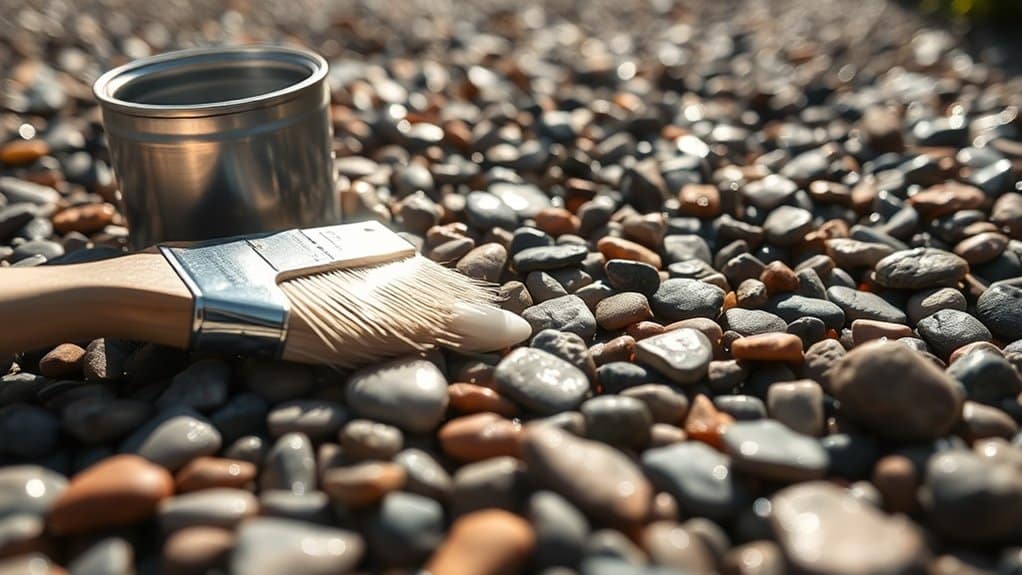
Choosing the right sealant for resin-bound gravel is crucial for ensuring your surface remains durable and lasts long. Here are some key factors to consider:
- UV Stabilisation: This helps prevent fading and deterioration due to sunlight.
- Flexibility: A flexible sealant can adapt to any movement in the substrate, which reduces the likelihood of cracks.
- Chemical Resistance: A good sealant will protect your surface from pollutants and cleaning products.
- Permeability: Ensure the sealant allows water to drain through, preventing pooling and potential freeze-thaw damage.
When picking a sealant, think about the local weather conditions and the level of traffic your surface will experience.
Proper surface preparation and applying the sealant under the right conditions are essential for achieving the best results and extending its lifespan.
Professional vs. DIY Sealant Application: Pros and Cons
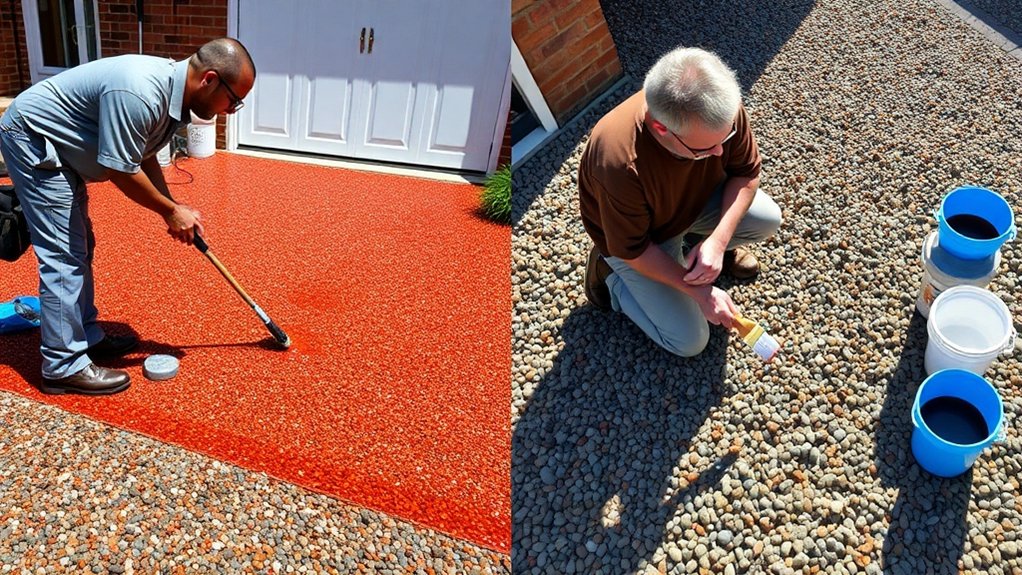
Considering whether to apply sealant to your resin-bound gravel yourself or hire a professional? It’s important to weigh the pros and cons.
Professionals have the expertise to ensure proper surface preparation and take environmental factors into account, reducing the risk of errors. They use advanced tools and high-quality sealants, which provide better adhesion and longer-lasting protection.
On the other hand, DIY sealant application comes with risks. Without adequate knowledge of curing times and weather conditions, you might end up with patchy coverage or premature wear.
While handling it yourself might seem like a cost-saving option, the potential for expensive repairs due to improper application can quickly negate those savings.
In the end, investing in professional services not only enhances durability but also maintains the aesthetic appeal of your gravel surface, protecting your investment through all seasons.
Frequently Asked Questions
How Do Sealants Affect the Color of Resin-Bound Gravel?
Sealants enhance the colour of resin-bound gravel by providing UV protection, which helps to prevent fading and discolouration. They keep the surface looking vibrant with a smooth, reflective layer that highlights contrasts and brightness. This not only improves the aesthetic appeal but also ensures the longevity of your resin-bound gravel surfaces. For instance, a sealant can make the bright stones in your driveway pop, while protecting them from the wear and tear of the British weather.
Can Sealants Be Applied in Wet Weather?
Yes, you can apply sealants in wet weather, but it’s not advisable. For the best results, sealants should be applied in dry conditions to ensure proper adhesion and durability. Working in the rain can lead to poor outcomes, making it a challenge you might want to avoid.
Are There Eco-Friendly Sealant Options Available?
Yes, eco-friendly sealant options are available that use biodegradable materials and natural ingredients. These sealants prioritise safety and environmental health while providing durability and low maintenance for your surfaces. They’re an excellent choice for sustainable projects.
What Are the Signs That Sealants Need Reapplication?
You’ll know it’s time to reapply sealant if you notice cracks, fading, or water pooling on the surface. These signs usually indicate that the sealant is wearing off, and reapplication is typically needed every 2-3 years to keep your surfaces looking their best and protect their integrity.
How Long Does Sealant Curing Take Before Use?
Sealant curing times generally vary from 6 hours in summer to 48 hours in winter, depending on the temperature at the time of application. It’s important to keep an eye on the conditions to ensure optimal drying and curing for your project. For instance, if you apply sealant on a chilly day, plan for a longer wait before use.
Conclusion
In summary, using sealants for resin-bound gravel is a smart choice for ensuring its longevity and durability. Regular reapplication and careful selection of the right sealant can significantly improve the surface’s resistance to wear and environmental factors. By taking advantage of sealants, you maintain not only the visual appeal but also protect your investment for years. Don’t leave your gravel exposed; safeguard it properly.
